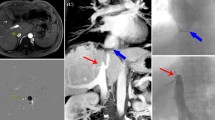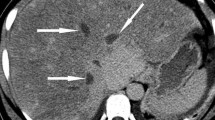Abstract
Purpose
To prospectively determine the value of blood flow velocity in the inferior vena cava (IVC) on color Doppler ultrasonography for the optimization of the delay in scanning time after contrast injection during computed tomography (CT) venography in patients with Budd–Chiari syndrome (BCS) with IVC obstruction.
Methods
We enrolled 122 consecutive BCS patients with IVC obstruction. All patients underwent color Doppler ultrasonography, CT venography, and digital subtraction angiography (DSA) in that order prior to treatment. The delay in scanning time during CT venography was set at 120, 180, 240, and 300 s after contrast injection. The correlation between delay in CT scanning and IVC blood flow velocity on color Doppler ultrasonography was explored. Image quality was classified as good, moderate, or poor. Patients with good CT image quality were considered to have an optimal delay in scanning time.
Results
Delays in scanning time of 120, 180, 240, and 300 s yielded good-quality images in 2, 7, 49, and 64 patients, respectively. The corresponding IVC blood flow velocities in these patients were 16.10 ± 0.42 cm/s (range 15.8–16.4 cm/s), 12.90 ± 1.58 cm/s (range, 11–15 cm/s), 7.53 ± 1.35 cm/s (range 5–10 cm/s), and 1.95 ± 1.75 cm/s (range 0–5.5 cm/s).
Conclusion
IVC blood flow velocity on color Doppler ultrasonography could serve as a useful tool for the optimization of the delay in scanning time during CT venography to ensure good-quality images for the diagnosis of BCS with IVC obstruction.

Similar content being viewed by others
References
Janssen HL, Garcia-Pagan JC, Elias E, Mentha G, Hadengue A, Valla DC (2003) Budd–Chiari syndrome: a review by an expert panel. J Hepatol 38:364–371
Murad SD, Plessier A, Hernandez-Guerra M, Fabris F, Eapen CE, Bahr MJ, Trebicka J, Morard I, Lasser L, Heller J, Hadengue A (2009) Etiology, management, and outcome of the Budd–Chiari syndrome. Ann Intern Med 151:167–175
Menon KN, Shah V, Kamath PS (2004) The Budd–Chiari syndrome. N Engl J Med 350:578–585
Xu K, Feng B, Zhong H et al (2003) Clinical application of interventional techniques in the treatment of Budd–Chiari syndrome. Chin Med J (Engl) 116:609–615
Qiao T, Liu CJ, Liu C et al (2005) Interventional endovascular treatment for Budd–Chiari syndrome with long-term follow-up. Swiss Med Wkly 135:318–326
Furui Sl, Sawada S, Irie T et al (1990) Hepatic inferior vena cava obstruction: treatment of two types with Gianturco expandable metallic stents. Radiology 176:665–670
Xu K, He FX, Zhang HG et al (1996) Budd–Chiari syndrome caused by obstruction of the hepatic inferior vena cava: immediate and 2-year treatment results of transluminal angioplasty and metallic stent placement. Cardiovasc Interv Radiol 19:32–36
Ding PX, Han XW, Wu G et al (2010) Outcome of a retrieval stent filter and 30-mm balloon dilator for patients with Budd–Chiari syndrome and old inferior vena cava thrombosis: a prospective pilot study. Clin Radiol 65:629–635
Meng QY, Sun NF, Wang JX et al (2011) Endovascular treatment of Budd–Chiari syndrome. Chin Med J (Engl) 124:3289–3292
Han G, Qi X, Zhang W et al (2013) Percutaneous recanalization for Budd–Chiari syndrome: an 11-year retrospective study on patency and survival in 177 Chinese patients from a single center. Radiology 266:657–667
Vogelzang RL, Anschuetz SL, Gore RM (1987) Budd–Chiari syndrome: CT observations. Radiology 163:329–333
Virmani V, Khandelwal N, Kang M et al (2009) MDCT venography in the evaluation of inferior vena cava in Budd–Chiari syndrome. Indian J Gastroenterol 28:17–23
Camera Ll, Mainenti PP, Di Giacomo A et al (2006) Triphasic helical CT in Budd–Chiari syndrome: patterns of enhancement in acute, subacute and chronic disease. Clin Radiol 61:331–337
Cai SFl, Gai YH, Liu QWl (2015) Computed tomography angiography manifestations of collateral circulations in Budd–Chiari syndrome. Exp Ther Med 9:399–404
Cho OKl, Koo JH et al (1996) Collateral pathways in Budd–Chiari syndrome: CT and venographic correlation. AJR Am J Roentgenol 167:1163–1167
De BKl, De KK, Sen S et al (2000) Etiology based prevalence of Budd–Chiari syndrome in eastern India. J Assoc Phys India 48:800–803
Eapen CE, Mammen T, Moses V et al (2007) Changing profile of Budd–Chiari syndrome in India. Indian J Astroenterol 26(1):77–81
Author information
Authors and Affiliations
Corresponding author
Ethics declarations
Conflict of interest statement
Peng-li Zhou declares that he has no conflict of interest.
Gang Wu declares that he has no conflict of interest.
Xin-wei Han declares that he has no conflict of interest.
Lei Yan declares that he has no conflict of interest.
Wen-Guang Zhang declares that he has no conflict of interest.
Ethical approval
All procedures performed in studies involving human participants were in accordance with the ethical standards of the institutional and/or national research committee and with the 1964 Helsinki declaration and its later amendments or comparable ethical standards.
Informed consent
Informed consent was obtained from all individual participants included in the study.
Additional information
L. Yan is the co-first auhtor.
Rights and permissions
About this article
Cite this article
Zhou, Pl., Yan, L., Wu, G. et al. Value of blood flow velocity on color Doppler ultrasonography for optimization of delay in scanning time on computed tomography venography in patients with Budd–Chiari syndrome and inferior vena cava obstruction. Radiol med 122, 399–404 (2017). https://doi.org/10.1007/s11547-017-0730-1
Received:
Accepted:
Published:
Issue Date:
DOI: https://doi.org/10.1007/s11547-017-0730-1




